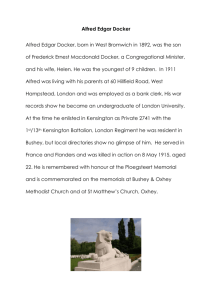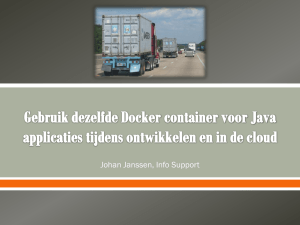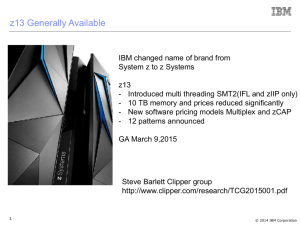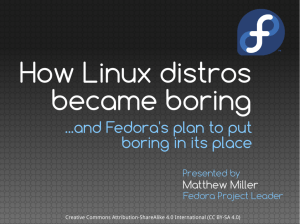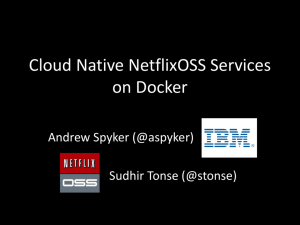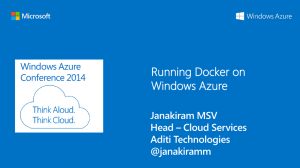Docker and HTCondor
advertisement
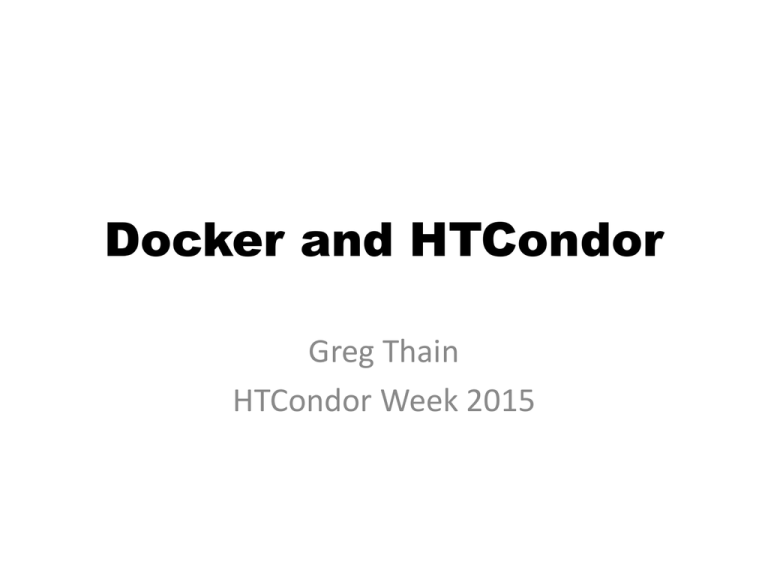
Docker and HTCondor Greg Thain HTCondor Week 2015 Start with the Basics… HTCondor is designed to: Allow a machine “owner” to loan it out The machine must be protected from job Ancient History: Chroot HTCondor used to chroot every job: 1. No job could touch the file system 2. Private files in host machine stayed private Chroot: more trouble than value Increasingly difficult to work: Shared libraries /dev /sys /etc /var/run pipes for syslog, etc. How to create root filesystem? Easier now with yum, apt get, etc., but still hard: Repos make images Easier* $ dnf -y --releasever=21 –nogpg installroot=/srv/mycontainer --disablerepo='*' --enablerepo=fedora install systemd passwd dnf fedora-release vim-minimal $ debootstrap --arch=amd64 unstable ~/debiantree/ $ pacstrap -c -d ~/arch-tree/ base We gave up! HTCondor no longer chroots all jobs But you can optionally do so. Very few site sites do… NAMED_CHROOT = /foo Enter Docker! This is Docker Docker manages Linux containers. Containers give Linux processes a private: • • • • Root file system Process space NATed network UID space Examples This is an “ubuntu” container Processes in other containers on this machine can NOT see what’s going on in this “ubuntu” container This is my host OS, running Fedora At the Command Line $ hostname whale $ cat /etc/redhat-release Fedora release 20 (Heisenbug) $ docker run ubuntu cat /etc/debian_version jessie/sid $ time docker run ubuntu sleep 0 real 0m1.825s user 0m0.017s sys 0m0.024s More CLI detail $ docker run ubuntu cat /etc/debian_version “cat” is the Unix process, from the image we will run (followed by the arguments) “ubuntu” is the base filesystem for the container an “image” “run” command runs a process in a container All docker commands are bound into the “docker” executable Images Images provide the user level filesystem Doesn’t contain the linux kernel Or device drivers Or swap space Very small: ubuntu: 200Mb. Images are READ ONLY Docker run two step Every image that docker run must be local How to get $ docker search image-name $ docker pull image-name Docker run implies pull first! run can fail if image doesn’t exist or is unreachable Where images come from Docker, inc provides a public-access hub Contains 10,000+ publically usable images behind a CDN What’s local? $ docker images $ docker images REPOSITORY new_ubu <none> <none> rocker/rstudio ubuntu busybox TAG latest <none> <none> latest latest latest IMAGE ID b67902967df7 dd58b0ec6b9a 1d19dc9e2e4f 14fad19147b6 d0955f21bf24 4986bf8c1536 How to get $ docker search image-name $ docker pull image-name CREATED 8 weeks ago 8 weeks ago 8 weeks ago 8 weeks ago 8 weeks ago 4 months ago VIRTUAL SIZE 192.7 MB 192.7 MB 192.7 MB 787 MB 192.7 MB 2.433 MB Image name hub.demo.org:8080/user/image:ver Image name and version: (default: “latest”) Name of the user (default: system user) Name of the hub (default docker-io) Wait! I don’t want my images public! Easy to make your own images (from tar files) The docker hub is open source Straightforward to start your own How is it distributed? Docker hub is an image! $ docker run docker/docker-registry (and a bunch of setup – google for details) Any production site will want to run own hub Or put a caching proxy in front of the public one Under the hood of images Images are composed of layers Images can share base layers: ubuntu : 200 Mb ubuntu + R : 250 Mb ubuntu + matlab : 250 Mb All three: 300 Mb. Container vs. Image Image is like Unix program on disk read only, static Container is like Unix process Docker run starts a container from an image Container states: like a condor job: Running Stopped Containers $ docker ps CONTAINER ID IMAGE COMMAND b71fff77e7b9 ubuntu:latest /bin/sleep NAMES owly_tannenba shows running containers $ docker ps –a CONTAINER ID IMAGE COMMAND b71fff77e7b9 ubuntu:latest /bin/sleep 7eff0a4dd0b4 debian:jessie /bin/sleep NAMES owly_tannenba owly_tannenba Operations on Containers $ docker ps –a $ docker run … $ docker stop containerId $ docker restart containerId $ docker rm containerId Where is my output? $ $ C A C D $ docker diff containerId sudo docker diff 7bbb /dev /dev/kmsg /etc /foo docker cp containerId:/path /host Works on running or stopped containers Or, use “volumes” $ docker run –v /host:/container … Volume is a directory that isn’t mapped Output to volume goes directly to host Fast: just a local mount Why should you care? • Reproducibilty – How many .so’s in /usr/lib64 do you use? – Will a RHEL 6 app run on RHEL 9 in five years? • Packaging – Image is a great to package large software stacks • Ease of inspection and management • Imagine an OSG with container support! I Know What You Are Thinking! Isn’t this a Virtual Machine? • Containers share Linux kernel with host • Host can “ps” into container – One-way mirror, not black box • Docker provides namespace for images • Docker containers do not run system daemons – CUPS, email, cron, init, fsck, (think about security!) • Docker images much smaller than VM ones – Just a set of files, not a disk image • Much more likely to be universally available Semantics: VM vs. Container • VMs provide ONE operation: – Boot the black box – Run until poweroff • Containers provide process interface: – Start this process within the contain – Run until that process exits – Much more Condor-like Docker and HTCondor • Package HTCondor as docker image • Add new “docker universe” – (not actually new universe id) Installation of docker universe Need condor 8.3.6+ Need docker (maybe from EPEL) $ yum install docker-io Docker is moving fast: docker 1.6+, ideally odd bugs with older dockers! Condor needs to be in the docker group! $ useradd –G docker condor $ service docker start What? No Knobs? Default install should require no condor knobs! But we have them anyway: DOCKER = /usr/bin/docker Condor startd detects docker $ condor_status –l | grep –i docker HasDocker = true DockerVersion = "Docker version 1.5.0, build a8a31ef/1.5.0“ $ condor_status –const HasDocker Check StarterLog for error messages Docker Universe universe = docker executable = /bin/my_executable arguments = arg1 docker_image = deb7_and_HEP_stack transfer_input_files = some_input output = out error = err log = log queue Docker Universe Job Is still a job • Docker containers have the job-nature – – – – – – – – – – condor_submit condor_rm condor_hold Write entries to the user log event log condor_dagman works with them Policy expressions work. Matchmaking works User prio / job prio / group quotas all work Stdin, stdout, stderr work Etc. etc. etc.* Docker Universe universe = docker executable = /bin/my_executable Executable comes either from submit machine or image NEVER FROM execute machine! Docker Universe universe = docker # executable = /bin/my_executable Executable can even be omitted! trivia: true for what other universe? (Images can name a default command) Docker Universe universe = docker executable = ./my_executable input_files = my_executable If executable is transferred, Executable copied from submit machine (useful for scripts) Docker Universe universe = docker executable = /bin/my_executable docker_image =deb7_and_HEP_stack Image is the name of the docker image stored on execute machine. Condor will fetch it if needed. Docker Universe universe = docker transfer_input_files= some_input HTCondor can transfer input files from submit machine into container (same with output in reverse) Condor’s use of Docker Condor volume mounts the scratch dir Condor sets the cwd of job to the scratch dir Can’t see NFS mounted filesystems! Condor runs the job with the usual uid rules. Sets container name to HTCJob_$(CLUSTER) _$(PROC)_slotName Scratch dir == Volume Means normal file xfer rules apply transfer in, transfer out subdirectory rule holds condor_tail works RequestDisk applies to scratch dir, not container Any changes to the container are not xfered Container is removed on job exit Docker Resource limiting RequestCpus = 4 RequestMemory = 1024M RequestDisk = Somewhat ignored… RequestCpus translated into cgroup shares RequestMemory enforced If exceeded, job gets OOM killed job goes on hold RequestDisk applies to the scratch dir only 10 Gb limit rest of container Why is my job on hold? Docker couldn’t find image name: $ condor_q -hold -- Submitter: localhost : <127.0.0.1:49411?addrs=127.0.0.1:49411> : localhost ID OWNER HELD_SINCE HOLD_REASON 286.0 gthain 5/10 10:13 Error from slot1@localhost: Cannot start container: invalid image name: debain Exceeded memory limit? Just like vanilla job with cgroups 297.0 gthain 5/19 11:15 Error from slot1@localhost: Docker job exhaused 128 Mb memory Surprises with Docker Universe Condor_ssh_to_job doesn’t work Condor_chirp doesn’t work Suspend doesn’t work Can’t access NFS/shared filesystems Job not a child of the condor_starter: Request_disk doesn’t work resource usage is funky Networking is only NAT Coming soon… • Advertise images we already have • Garbage collection of used images • Report resource usage Potential Features? Network support? Better than NAT? LARKy? Support for shared filesystems? Mapping other directories to containers? Get entire container diff back? Run containers as root? Mount fake /proc/cpuinfo and friends condor_ssh_to_job Automatic checkpoint and restart of containers! Surprises with Docker Moving fast – bugs added/removed quickly 10 Gb limit on container growth Security concerns Adding new hub requires ssl cert on client Containers don’t nest by default Docker needs root – problem for glidein No support for Windows/Mac/BSD or other Everyone shares a linux kernel The “init” problem The “init” problem Or, “How come my docker job isn’t exiting” Docker process runs as pid 1 in pid namespace Linux blocks all unhandled catchable signals Soft kills usually don’t work shell wrapper fixes condor_pid_ns_init Alternatives to docker RedHat: Rocket Systemd: nspawn Summary Docker universe coming to Condor Could be game-changing Very interested in user feedback THANK YOU!
